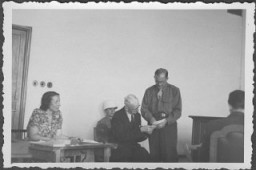You searched for: world war I
<< Previous | Displaying results 101-124 of 534 for "world war I" | Next >>
-
The British Policy of Appeasement toward Hitler and Nazi Germany
ArticleIn the 1930s, Prime Minister Neville Chamberlain and the British government pursued a policy of appeasement towards Nazi Germany to avoid war. Learn more.
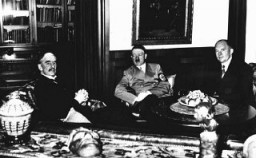
-
Siege (1940)
ArticleJulien Bryan’s ten-minute film Siege, first non-Nazi produced footage of the start of WWII, records horror and chaos in Warsaw following the German invasion.
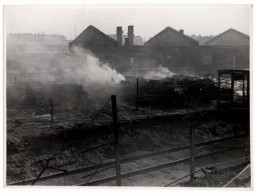
-
Timeline of the German Military and the Nazi Regime
ArticleKey dates illustrating the relationship between Germany’s professional military elite and the Nazi state, and the German military’s role in the Holocaust.
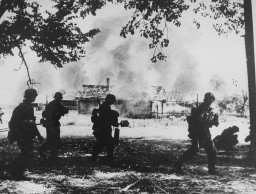
-
Nazi Territorial Aggression: The Anschluss
ArticleThe Anschluss, Germany's annexation of Austria in March 1938, was the Nazi German regime’s first act of territorial aggression and expansion. Learn more.
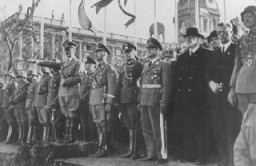
-
Jewish Community of Monastir: A Community in Flux
ArticleThe Sephardic Jewish community of Monastir was historically the largest Jewish community in Macedonia. Learn about the community before and during WWII and the Holocaust.
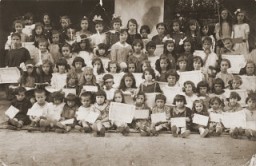
-
Erwin Rommel
ArticleErwin Rommel was commander of the German Afrika Korps in North Africa during WWII. Learn about Rommel's military career, death, and ongoing questions around his commitment to Nazism.
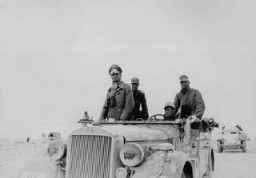
-
Concentration Camps, 1939–42
ArticleAs Germany conquered much of Europe, the concentration camp system expanded in size, function, and number of prisoners. Learn about concentration camps from 1939–1942.
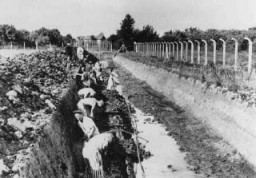
-
German Armed Forces High Command
ArticleThe German Armed Forces High Command, headed by Hitler, directed Germany’s armed forces before and during WWII. It was deeply complicit in the Holocaust and other crimes of the Third Reich.
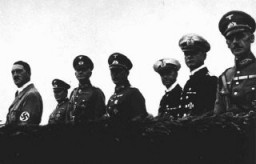
-
What conditions, ideologies, and ideas made the Holocaust possible?
Discussion QuestionThe leaders of Nazi Germany, a modern, educated society, aimed to destroy millions of men, women, and children because of their Jewish identity. Understanding this process may help us to better understand the condit...
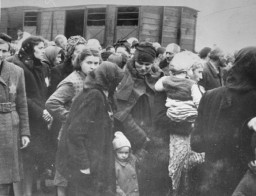
-
The Nazi Party
ArticleThe National Socialist German Worker’s Party, also known as the Nazi Party, was the far-right racist and antisemitic political party led by Adolf Hitler.
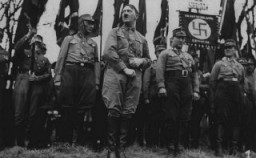
-
Japanese American Relocation
ArticleLearn more about the forcible relocation of some 120,000 people of Japanese descent living in the US to “relocation centers.”
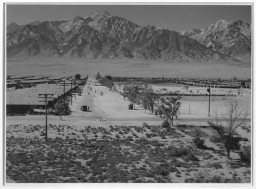
-
Hajj Amin al-Husayni: Wartime Propagandist
ArticleFormer Mufti of Jerusalem Hajj Amin al-Husayni was an exiled political leader who sought an alliance with the Axis Powers. Learn about his wartime propaganda efforts.

-
Belle Mayer Zeck describes research about IG Farben for the postwar trial
Oral HistoryBelle Mayer trained as a lawyer and worked for the General Counsel of the US Treasury, Foreign Funds Control Bureau. This bureau worked to enforce the Trading With the Enemy Act passed by Congress. In this capacity, Mayer became familiar with the German I. G. Farben chemical company, a large conglomerate that used slave labor during World War II. In 1945, Mayer was sent as a Department of Treasury representative to the postwar London Conference. She was present as representatives from the Allied nations…
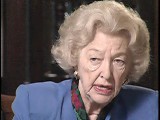
-
Allied Military Operations in North Africa
ArticleLearn about the North African military campaigns of World War II which took place between September 13, 1940, and May 13, 1943.
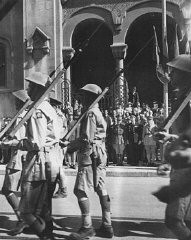
-
Invasion of Poland, Fall 1939
ArticleThe German invasion of Poland in the fall of 1939 triggered WWII. Learn more about key dates and events, causes, and related Holocaust history.
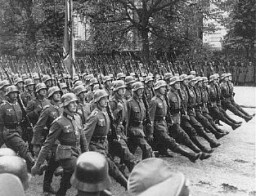
-
Franklin Delano Roosevelt
ArticleFranklin D. Roosevelt was 32nd president of the US. Learn about the domestic and international challenges FDR faced as president during World War II.
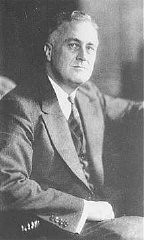
-
Leo Melamed describes fear after German occupation of Bialystok
Oral HistoryLeo was seven years old when Germany invaded Poland in September 1939. Before the war, Leo's father was a mathematics teacher and member of the Bialystok City Council. Fearing arrest, Leo's father fled Bialystok for Vilna just before the German occupation. Leo and his mother eventually joined his father in Vilna. After the Soviets occupied Vilna, Leo's father obtained transit visas to Japan. The family left Vilna in December 1940, traveled across the Soviet Union on the Trans-Siberian Express, and arrived…
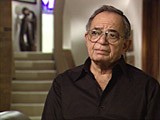
-
Introduction to the Holocaust
ArticleLearn about the Holocaust, the systematic, state-sponsored persecution and murder of six million Jews by the Nazi regime and its collaborators.

-
Bomb damage in Nuremberg
PhotoView of the bombed-out city of Nuremberg. Visible in the distance is the twin-spired Lorenz Church, and on the right, a statue of Kaiser Wilhelm I. Nuremberg, Germany, 1945.
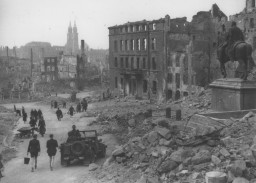
-
Subcarpathian Rus (Ukraine)
ArticleLearn more about the Transcarpathian region of Ukraine (Subcarpathian Rus) before and during World War II.
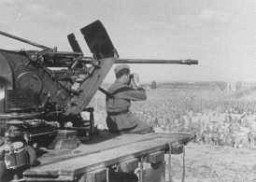
-
Deceiving the Public
ArticleThe Nazis frequently used propaganda to disguise their political aims and deceive the German and international public. Learn more.
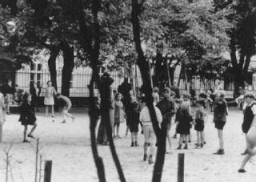
-
Henry Morgenthau Jr.
ArticleHenry Morgenthau Jr had a key role in creating and operating the War Refugee Board, a government agency tasked with rescuing and providing relief for Jews during the Holocaust.
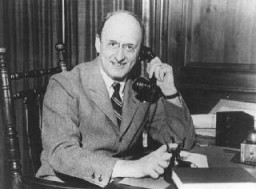
-
Jewish Community of Kalisz: Economy, Politics, Government
ArticleEconomic, governmental, and political life in the Jewish community of Kalisz between World War and World War II.
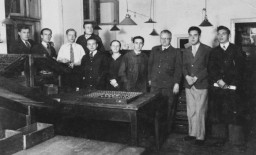
-
Reversal of Fortune: Robert Kempner
ArticleLawyer Robert Kempner was expelled from Germany in 1935. After WWII, he would return to serve as assistant US chief counsel during the IMT at Nuremberg.
